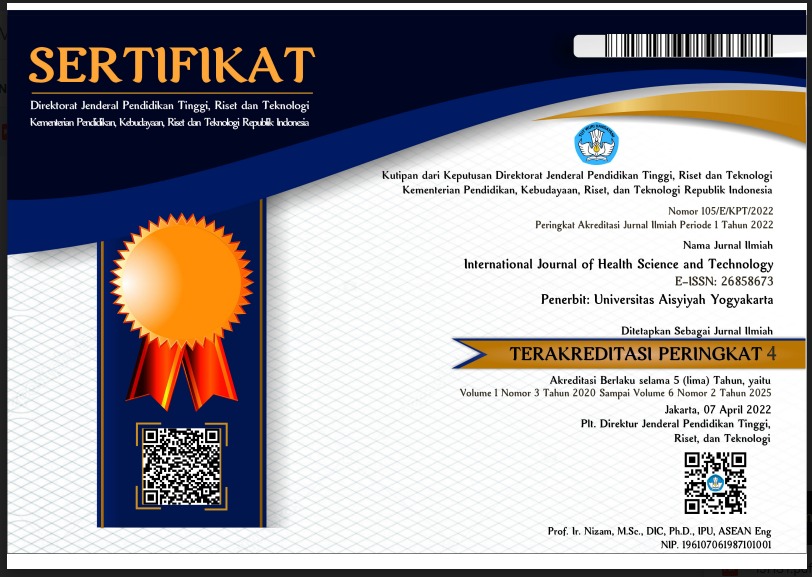Association information sources of reproductive health with sexual behavior of adolescents in Indonesia
DOI:
https://doi.org/10.31101/ijhst.v1i3.1214Keywords:
information sources, reproductive health, adolescent sexualAbstract
References
Arik V.Marcell, G. R. B. (2017) .Sexual and Reproductive Health Care Services in the Pediatric Setting. American Academy Of Pediatrics. doi: https://doi.org/10.1542/peds.2-17-2858.
Cheong, J. I. et al. (2015). The effect of early menarche on the sexual behaviors of Korean female adolescents. Annals of Pediatric Endocrinology & Metabolism, 20(3), p. 130. doi: 10.6065/apem.2015.20.3.130.
Elena Regushevskaya, Tatiana Dubikaytis, Made Laanpere, Minna Nikula, Olga Kuznetsova, Elina Haavio-Mannila, Hele Karro, E. H. (2009) .Risk factors for induced abortions in St Petersburg, Estonia and Finland. Results from surveys among women of reproductive age Elena. The European Journal of Contraception and Reproductive Health Care, pp. 176–186. doi: 10.1080/13625180902916038.
Heidi A. Lyons, Wendy D. Manning, Monica A. Longmore, P. C. G. (2015). Gender and Casual Sexual Activity From Adolescence to Emerging Adulthood: Social and Life Course Correlates. The Journal Of Sex Research. doi: 10.1080/00224499.2014.906032.
Kathryn A. Brookmeyer, Oscar Beltran, N. A. (2017). Understanding the Effects of Forced Sex on Sexually Transmitted Disease Acquisition and Sexually Transmitted Disease Care: Findings From the National Survey of Family Growth (2011–2013) Title. American Sexually Transmitted Diseases. doi: 10.1097/OLQ.0000000000000651.
Kementerian Kesehatan (2014) Infodatin Pusat Data dan Informasi Kementerian Kesehatan RI.
Laura Widman, Sophia Choukas-Bradley, Seth M. Noar, Jacqueline Nesi, K. G. (2016) . Parent- Adolescent Sexual Communication andAdolescent Safer Sex Behavior A Meta-Analysis. American Medical Association. doi: 10.1001/jamapediatrics.2015.2731.
Lesley-Anne Ey, E. M. and To (2017). Educators’ Observations of Children’s Display of Problematic Sexual Behaviors in Educational Settings. Journal Of Child Sexual Abuse. doi: 10.1080/10538712.2017.1349855.
Measure DHS. (2012). Survei Demografi dan Kesehatan Indonesia 2012 Kesehatan Reproduksi Remaja.
Miguel Ruiz-Canela, Cristina Lopez-del Burgo, Silvia Carlos, Maria Calatrava, Alfonso Osorio, y J. de I. (2013). Familia, amigos y otras fuentes de información asociadas al inicio de las relaciones sexuales en adolescentes de El Salvador. Rev Panam Salud Publica, pp. 54–61.
Planning, F. (2016). Reducing early and unintended pregnancies among adolescents. Family Planning, pp. 1–4.
Satoko Tsuda, Sri Hartini, Elsi Dwi Hapsari, S. T. (2017) . Sex Education in Children and Adolescents With Disabilities in Yogyakarta, Indonesia From a Teachers’ Gender Perspective. Sagepub. doi: i.org/10.1177/1010539517702716.
Schenita D. Randolph, Tanya Coakley, Jeffrey Shears, R. J. T. J. (2017) . African-American Fathers’ Perspectives on Facilitators and Barriers to Father–Son Sexual Health Communication. Research In Nursing & Health. doi: 10.1002/nur.21789.
Takele Gezahegn, Zewdie Birhanu, Mamusha Aman, Muluken Dessalegn, Asmamaw Abera, J. N. (2016) .Peer communication on sex and sexual health among youths: a case of Debre Berhan university, Ethiopia. Medical Journal. doi: 10.11604/pamj.supp.2016.25.2.9631.
Terence P. Thornberry, Marvin D. Krohn, Megan Bears Augustyn, Molly Buchanan, S. J. G. (2015). The impact of adolescent risk behavior on partner relationships. Elsevier, p. 16.
Wendy Heywood, Kent Patrick, Anthony M.A.Smith, M. K. (2014). Associations Between Early First Sexual Intercourse and Later Sexual and Reproductive Outcomes: A Systematic Review of Population- Based Data. Australian Research Centre in Sex, Health & Society. doi: 10.1007/s10508-014-0374-3.
Downloads
Published
How to Cite
Issue
Section
Citation Check
License
International Journal of Health Science and Technology allows readers to read, download, copy, distribute, print, search, or link to its articles' full texts and allows readers to use them for any other lawful purpose. The journal allows the author(s) to hold the copyright without restrictions. Finally, the journal allows the author(s) to retain publishing rights without restrictions
- Authors are allowed to archive their submitted article in an open access repository
- Authors are allowed to archive the final published article in an open access repository with an acknowledgment of its initial publication in this journal

This work is licensed under a Creative Commons Attribution-ShareAlike 4.0 Generic License.










